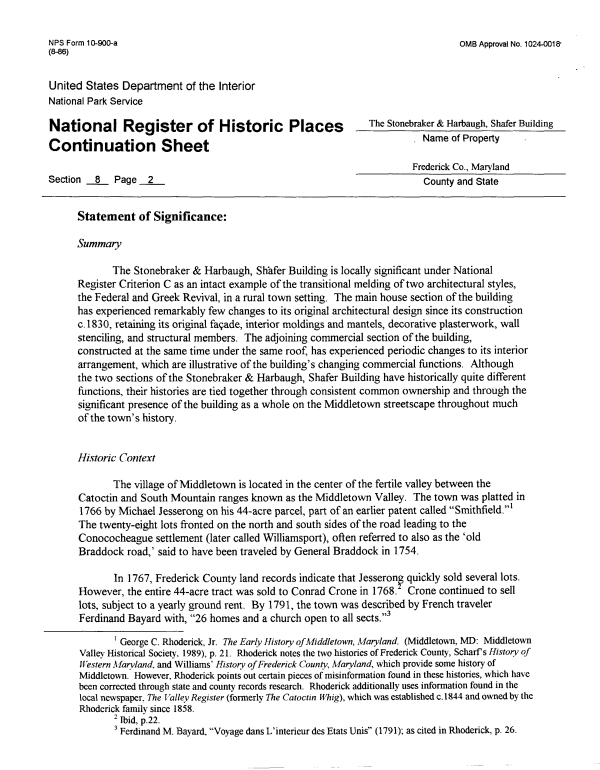 |
||||
|
DEPARTMENT OF HOUSING AND COMMUNITY DEVELOPMENT, MARYLAND HISTORICAL TRUST (Historic Sites Survey) var.d. MSA SE16-6 Image No: se16-6-0267 Enlarge and print image (69K) |
 |
||||
|
DEPARTMENT OF HOUSING AND COMMUNITY DEVELOPMENT, MARYLAND HISTORICAL TRUST (Historic Sites Survey) var.d. MSA SE16-6 Image No: se16-6-0267 Enlarge and print image (69K) |
| NFS Form 10-900-a (8-86) OMB Approval No. 1 024-001 81 United States Department of the Interior National Park Service National Register of Historic Continuation Sheet Section 8 Page 2 The Stonebraker & Harbaugh, Shafer Building Name of Property ______Frederick Co., Maryland______ County and State Statement of Significance: Summary The Stonebraker & Harbaugh, Shafer Building is locally significant under National Register Criterion C as an intact example of the transitional melding of two architectural styles, the Federal and Greek Revival, in a rural town setting. The main house section of the building has experienced remarkably few changes to its original architectural design since its construction c. 1830, retaining its original fa9ade, interior moldings and mantels, decorative plasterwork, wall stenciling, and structural members. The adjoining commercial section of the building, constructed at the same time under the same roof, has experienced periodic changes to its interior arrangement, which are illustrative of the building's changing commercial functions. Although the two sections of the Stonebraker & Harbaugh, Shafer Building have historically quite different functions, their histories are tied together through consistent common ownership and through the significant presence of the building as a whole on the Middletown streetscape throughout much of the town's history. Historic Context The village of Middletown is located in the center of the fertile valley between the Catoctin and South Mountain ranges known as the Middletown Valley. The town was platted in 1766 by Michael Jesserong on his 44-acre parcel, part of an earlier patent called "Smithfield."1 The twenty-eight lots fronted on the north and south sides of the road leading to the Conococheague settlement (later called Williamsport), often referred to also as the 'old Braddock road,' said to have been traveled by General Braddock in 1754. In 1767, Frederick County land records indicate that Jesserong quickly sold several lots. However, the entire 44-acre tract was sold to Conrad Crone in 1768. Crone continued to sell lots, subject to a yearly ground rent. By 1791, the town was described by French traveler Ferdinand Bayard with, "26 homes and a church open to all sects." 1 George C. Rhoderick, Jr. The Early History of Middletown, Maryland. (Middletown, MD: Middletown Valley Historical Society, 1989), p. 21. Rhoderick notes the two histories of Frederick County, Scharf s History of Western Maryland, and Williams' History of Frederick County, Maryland, which provide some history of Middletown. However, Rhoderick points out certain pieces of misinformation found in these histories, which have been corrected through state and county records research. Rhoderick additionally uses information found in the local newspaper. The Valley Register (formerly The Catoctin Whig), which was established c. 1844 and owned by the Rhoderick family since 1858. 2 Ibid, p.22. 3 Ferdinand M. Bayard, "Voyage dans L'interieur des Etats Unis" (1791); as cited in Rhoderick, p. 26. |